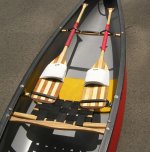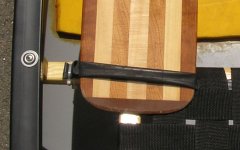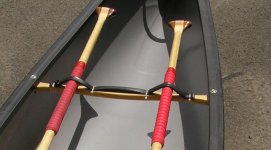Last time out I decided to use a dedicated yoke for carrying the Argosy on my back while portaging. Usually I use the old "strapped in paddles method" as shown in the accompanying photo but this time I did not want to appear to "traditionalist" to my friend from Connecticut who is a WC/Duluth type guy. I quickly found out I made a mistake. With the "dedicated" yoke the canoe has to travel much higher over the shoulders to set the yoke in place so the delts get quite involved. With the "paddles" method the canoe lift to get the paddles on the shoulders does not involve using the shoulder muscles as the canoe does not have to go as high. However my main disappointment in the "dedicated" yoke was in rainy conditions as the yoke clamps, no matter how tight I put them, kept on slipping out of position on the wet gunnels and the yoke would not stay set in the mid point position.
Interested in how other set up for portaging their solo boats.
Forgot to mention that the paddles are cared for in the "paddles" method and are helpful rather than being extra gear to carry.

Interested in how other set up for portaging their solo boats.
Forgot to mention that the paddles are cared for in the "paddles" method and are helpful rather than being extra gear to carry.

Last edited:


